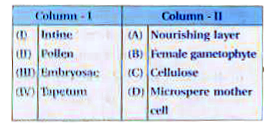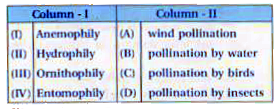Which of the following is true for anisogametes ?
(I) Morphologically and physiologically distinct.
(II) Similar in appearance
(III) Male gametes are smaller and active.
(IV) Female gametes are large and sulggish
(A) (I), (II)
(B) (II), (III), (IV)
(C) (I), (IV)
(D) (I), (III), (IV)Solution in Gujrati
(I), (II)
(II), (III), (IV)
(I), (IV)
(I), (III), (IV)
The correct Answer is:D
Step by step video, text & image solution for Which of the following is true for anisogametes ? (I) Morphologically and physiologically distinct. (II) Similar in appearance (III) Male gametes are smaller and active. (IV) Female gametes are large and sulggish (A) (I), (II) (B) (II), (III), (IV) (C) (I), (IV) (D) (I), (III), (IV) by Biology experts to help you in doubts & scoring excellent marks in Class 12 exams.
Updated on:21/07/2023Topper's Solved these Questions
- REPRODUCTION IN ORGANISMSBOOK - KUMAR PRAKASHANCHAPTER - REPRODUCTION IN ORGANISMSEXERCISE - SECTION - E SOLUTION OF NCERT EXEMPLAR (Long Answer Type Questions)
5 Videos
- PRINCIPLES OF INHERITANCE AND VARIATION BOOK - KUMAR PRAKASHANCHAPTER - PRINCIPLES OF INHERITANCE AND VARIATION EXERCISE - SECTION -F (MULTIPLE CHOICE QUESTIONS (MCQS)) (MCQs ASKED IN COMPETITIVE EXAM)
38 Videos
- REPRODUCTIVE HEALTH BOOK - KUMAR PRAKASHANCHAPTER - REPRODUCTIVE HEALTH EXERCISE - Section - F Multiple Choice Questions (MCQs)
102 Videos
Similar Questions
Enumerate the differences between asexual and sexual reproduction. Describe the types of asexual reproduction exhibited by unicellular organisms.
View SolutionThe incorrect statement with regard to haemophilia is
View SolutionWhich problems arise due to uncontrolled population growth ?
View SolutionPredict the order of reactivity of following compounds in dehydrohalogenation. a. I. II. III. IV. V. b. I. II. III. IV.
View SolutionMatch the column-
Column IColumn IIA Toxinsi. MorphineB Alkaloidsii. AbrinC Lectinsiii. VinblastinD. Drugsiv. Concanavalin A
ABCDiiiiiiiviiiiiiiviiiiviiiviiiiii
View SolutionMatch the followings and choose the correct answer. (A) (a - ii), (b - iii), (c - iv), (d - i) (B) (a - iii), (b - ii), (c - iv), (d - i) (C) (a - i), (b - iii), (c - ii), (d - iv) (D) (a - ii), (b - iv), (c - iii), (d - i)
View SolutionMatch the following with reference to cockroach and choose the correct option. (A) (a - iii), (b - iv), (c - ii), (d - i) (B) (a - iv), (b - iii), (c - ii), (d - i) (C) (a - iv), (b - ii), (c - iii), (d - i) (D) (a - ii), (b - iv), (c - iii), (d - i)
View SolutionMatch the followings and choose the correct answer.

(A) (a - iii), (b - i), (c - ii), (d - iv)
(B) (a - ii), (b - i), (c - iv), (d - iii)
(C) (a - iii), (b - iv), (c - ii), (d - i)
(D) (a - iii), (b - i), (c - iv), (d - ii)
View SolutionMatch the following column .
Column -I Column-II (a) Molecular oxygen (i) α− ketoglutaric acid (b) Electron acceptor (ii) Hydrogen acceptor (c) Pyruvate dehydrogenase (iii) Cytochrome -C (d) Decarboxylation (iv) Acetyl Co-A
(A) (a-ii),(b-iii),(c-iv),(d-i)
(B) (a-iii),(b-iv),(c-ii),(d-i)
(C) (a-ii),(b-i),(c-iii),(d-iv)
(D) (a-iv),(b-iii),(c-i),(d-ii)
View SolutionMatch the two columns: (A) (I-A),(II- B), (III- D), (IV- C) (B) (I-B), (II-A), (III-D), (IV - C) (C) (I- A), (II-B), (III-C), (IV- D) (D) (I- D), (II- A), (III-C), (IV-B)
View SolutionMatch the two columns:

(A) (I-C), (II-D), (III-B), (IV-A)
(B) (I-D), (II-C), (III-A), (IV-B)
(C) (I-C), (II-B),(III-D), (IV-A)
(D) (I-B),(II-D),(III-C),(IV-A)
View SolutionMatch the two columns:

(A) (I-A), (II-B), (III-C), (IV-D)
(B) (I-B), (II-A), (III-C), (IV-D)
(C) (I-A), (II-C), (III-B), (IV-D)
(D) (I-D), (II-B), (III-C), (IV-A)
View SolutionMatch the animals given in column A with their location in column B.
Column AColumn B(i)DodoA.Africa(ii)QuaggaB.Russia(iii)ThylacineC.Mauritius(iv)Stellar's sea cowD.Australia
Choose the correct match from the following.
(a) i-A, ii-C, iii-B, iv-D
(b) i-D, ii-C, iii-A, iv-B
(c) i-C, ii-A, iii-B, iv-D
(d) i-C, ii-A, iii-D, iv-B
View SolutionPredict the order of reactivity of following compounds in dehydrohalogenation. a. I. II. III. IV. V. b. I. II. III. IV.
View Solution
1 a(iii), b(ii), c(i), d(iv)
2 a(i), b(iv), c(i), d(iii)
3 a(iv), b(i), c(iii), d(iv)
4 a(ii), b(iii), c(iv), d(i)
View Solution
